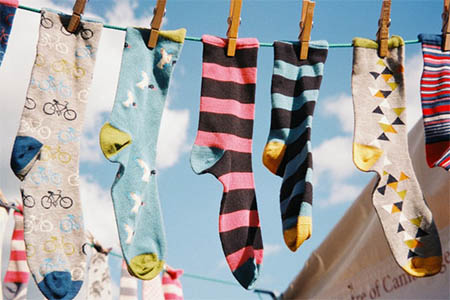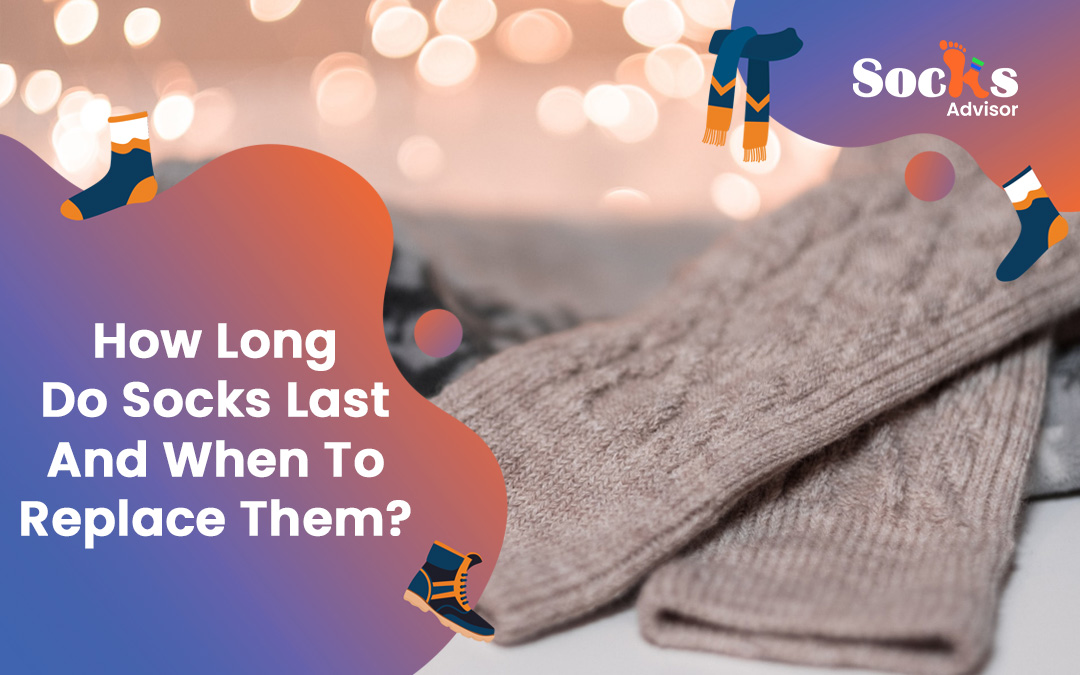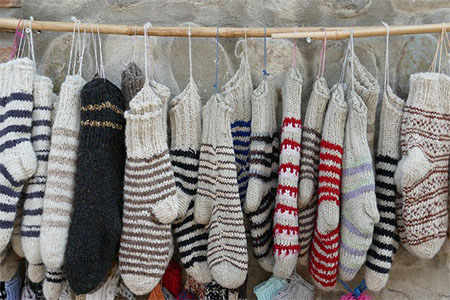Are you also among the ones who want their dear things to last longer? We all love it right? Especially the things we pay for. But there are few things that we buy once and expect to last forever. For example socks. However, this doesn’t always happen. They get torn, thin, or may lose their shape and get saggy. But the question is how often does this happen? And how long do socks last?
Good quality socks can last for a long time. Some take a month to expire while others may survive years. It all depends on how roughly you have used them. Sometimes it takes a few months to lose the stretchiness. However, the fabric of the socks survives more.
Since socks are prone to dirt, friction, abrasion, and losing elasticity there is a lot more care needed if you want them to last long. It doesn’t mean to lock them in a cupboard so they last forever. But careful use, regular replacement, and good quality material can guarantee a long shelf life for your socks.
Do good quality socks have a longer life span?
It is always said that high-quality socks have an edge when it comes to long shelf life. High quality doesn’t always mean brand and expensive products. But it combines the material, offered features, use of technology, and positive feedback from the customers.
After combining all these aspects they’re labeled as quality socks. Quality socks most of the time are durable and resistant to wear. They usually last up to six months or a year. Are designed according to the customer’s need these socks may serve all-purpose, everyday use, or specific functionality.
But such socks can also fall apart as a result of low maintenance, however, there is no need to worry because in this article we are gonna discuss how you can increase the lifespan of socks and when is the time for making a replacement.
Let’s get set.
- Do good quality socks have a longer life span?
- What guarantees the lifespan of your socks?
- Steps to increase sock’s life:
- Factors influencing sock’s lifespan
- 1. Friction:
- 2. Quality of the material of the socks:
- 3. Construction and knitting of the socks:
- 4. Well-fitting socks last long:
- 5. Activities you do:
- 6. Pairing socks with the right shoe:
- 7. Numbers of wear define life:
- 8. Unfolded or misplaced socks might get lost:
- 9. Dyes play a role in the life span of your socks:
- 10. Washing too much will reduce the lifespan of socks:
- Things you should remember while washing your socks
- My Final Thoughts:
What guarantees the lifespan of your socks?
To understand the phenomenon involved in increasing the lifespan of socks, It is very important to notice the fabric and construction of the socks. Quality of the material and production of the socks, how well you wear them, and how much you care about them. All these things in combination guarantee the lifespan of your socks.
What are the signs that indicate the time of sock replacement?
Replacing socks or making necessary amendments to them depends on the below-mentioned points.
- The socks lose reinforcement and there is an appearance of the hole
- Elasticity is no longer the same and the socks aren’t stretching anymore
- The socks get saggy and cause discomfort.
- Socks piling in feet or rolling down the ankle
- Fading of colors and thinning of material
Although all these reasons make no room for recovering your favorite stockings, this statement does not make any stance in consideration of the below-mentioned steps that showcase the ways to save your dear socks if they are not as damaging as the above-mentioned conditions.
Steps to increase sock’s life:
Ways to increase socks life may sound tricky but it’s not all. You might also be thinking of buying expensive products to get the job done but you will be amazed to know how easily by the use of natural products you can treat your favorite socks.
- Washing with hands and cold water since cold water is good at removing stains. It also stiffs the thread kneads while hot water loosens them.
- Avoid bleach and chemicals to keep them organic and fresh.
- Trim your feet’ nails since pointed nails can tear the sock fabric in the toes. The heel and toe are also supposed to be pressure points of socks and are very much susceptible to holes.
- Wash them in pairs and place them properly to not lose them.
- Have spare socks or three pairs at a time so that they don’t tear off soon. For this purpose, you can explore Adidas socks, the top 10 of which we have reviewed in our previous article with all the necessities you would like to know for intending to buy them.
Factors influencing sock’s lifespan
There are multiple reasons that influence the life span of socks. All or a combination of a few of these reasons influence the lifespan of your socks up to the greater extent
1. Friction:
Socks are made of thread and fibers. These fibers are meant to protect the foot. The foot is in a constant state of motion. This motion causes friction. The friction of the shoes, socks, and feet can damage the fibers used in the socks causing them to fall apart.
This makes socks thin and holey. Sometimes, the friction may result in the development of blisters or skin abrasions. Also, rigorous events, walking, and rough use can cause socks to tear apart due to friction. Therefore, it is vital to wear socks with a good fit, quality material, and construction.
Such socks may come pricey. But it is more intelligent to spend once a few months than spending every once a week.
2. Quality of the material of the socks:
If you are someone who doesn’t bother to pay attention to the material of the socks then it is likely that your socks won’t last. Bad quality material will lead to the development of holes, shrinkage, or loose socks.
The material of the fabric used decides the life span of your socks. Socks fabric is constructed according to the diameter of the fiber which offers both strength and comfort. Some fabrics are more durable as compared to others.
Socks with synthetic fabric like nylon, polyester, and elastane are extra heavy-duty and perfect for sports activities. They are also resilient to wearing and washing. However, natural fibers such as wool due to their delicate nature are not recommended to be used for everyday use and walking activities.
This is because of a lack of strength and piling up. Socks with a combination of both natural and synthetic fiber are great options. The manufacturers use a combination of fabric blended in yarn to strengthen functionality. A blend of 75% natural fiber to 25% synthetic fiber is considered best for both moisture-wicking and strength.
3. Construction and knitting of the socks:
Most socks are labeled as “durable”. Most of it is because of the material along with the construction. Such socks are intelligently designed to achieve sustainability. It features specified knitting and stitching.
For example, some socks’ fabric is reinforced in high-impact areas such as toes and heels. Toes and heels are more prone to friction and develop holes. The reinforcement in these areas helps the socks to last a little more.
Also, socks are carefully woven for a snug fit. A deep heel formation in socks ensures a proper fit. Similarly, the mesh design or flat stitching also increases stability and durability. It enhances the endurance for heavily pressured points of the foot. All these features in socks aim for long-term durability.
4. Well-fitting socks last long:
Movement and friction reduce the sock’s lifespan. Well-fitting socks ensure less friction on the yarn fibers. This prevents the formation of holes and abrasions. Too small socks put a stretch on the fabric making it thin and causing it to wear easily.
Even a grown nail will cause them to wear. While, baggy socks pile up beneath heels and toes, resulting in fabric friction and breakdown of the socks. Only properly fitting socks in proper shoes will last long.
5. Activities you do:
Socks are constructed according to the activities you used them for. Everyday socks are not as durable and functional as sports socks. Sports and hiking socks are constructed thick and durable enough to endure friction and rough use.
Therefore, it is important to determine the purpose of the socks you wear. If you have socks specific for each activity then it is more likely that they will last long.
However, if you use everyday socks for walking and sports then the friction and sweat will break down the fabric. In such a case, the socks won’t last long.
6. Pairing socks with the right shoe:
Socks spend most of their life inside their shoes. It is important to pair them with the right shoe. A pair of socks with appropriate thickness and fitting will ensure long life. Otherwise, there is a risk of common blisters, rubbing, and other foot problems.
Moreover, not wearing any shoes can reduce the sock’s life. Carpeted floors, rough floors, and concrete will make socks develop holes very early. If you wear merino wool socks then you should avoid wearing them all day on the floor without wearing shoes.
7. Numbers of wear define life:
If you are someone who wears a pair of socks two-three times a week then most probably your socks will last from 2 to a few months. And it becomes important to replace the socks. But more careful users keep two-three pairs of socks to be worn in a week.
This reduces the number of washes of each pair and increases the lifespan. All socks have a specific time of wear. The more often you wear socks the more likely it is to run out. Most quality socks offer long usage whereas others do not. It depends on how regularly you use them and the quality of the product.
8. Unfolded or misplaced socks might get lost:
If socks are not placed properly you may lose them. If one sock gets lost there is no use of the other one. This is why it is important to mention that losing one pair of socks will make you buy another one. Therefore, it is recommended to fold them and place them securely. In short, be organized and you will make your socks last longer.
Below are some good socks folding practices:
- Place one sock above another.
- Fold them in half
- Flip them over from the opening.
9. Dyes play a role in the life span of your socks:
Dyes are used in socks to make them cheerful and trendy. However, all dyes are chemicals. They eat out the fabric slowly and gradually. But the dyes used today are prepared with a composition that does not affect the skin or the fabric.
But cheap quality socks still use dyes that can be damaging to your socks. So it is very right to say that dyes play a role in the lifespan of your socks.
10. Washing too much will reduce the lifespan of socks:
Smell, sweat, and dirt are convincing enough for you to throw socks into the washing machine. This can be bad. The detergent, softener, bleaching, and friction with other clothes will make the threads of the socks weak.
The socks will wear out and lose their elasticity. This is more damaging to socks with natural fibers. Natural fibers have the high property of being moisture-wicking. It is not necessary to wash such socks more often. But if you have decided to wash them then wash them with care.
Things you should remember while washing your socks

- Air-drying socks can be an alternative to washing
- Avoid using hot water.
- Wash with cold water and hand wash them
- Turn socks inside out before washing them
- Avoid drying in the sun or near a heater. It can cause them to shrink.
- Follow the washing instructions the socks come with.
- Do not iron or hot-air dry your socks
- Line drying is the best thing to do.
- The friction of one cloth rubbing against the other in the washing machine and dryer damages the fabric with every wash.
- If you want to wash your socks in the machine, then wash them inside out.
- A cold machine wash is recommended.
- Don’t put natural fabric socks in the dryer
A reflection on why good quality socks are important:
Socks are the main component of our outfits. Socks can make your image or ruin it within seconds. Consider a person with a great outlook and expensive shoes. But inside his mind, he’s afraid of taking off his shoes. And that is because his socks are torn.
Well nobody can blame him of course. Socks are the most overlooked part of our outfits. Therefore, when you buy socks your first question could be how long do socks last. Well, it depends on their construction and the manner in which you used them.
If you haven’t used your socks then they most probably would last forever otherwise one year is the time limit for good quality and well-cared socks.
My Final Thoughts:
I hope I made you clear on how long socks last. For your understanding, Good quality socks last for about six months or a year. Sometimes, socks lose their elasticity but can be worn for a long. It is possible to enhance the life of the socks.
This is done through proper care, cold wash, reducing the number of washes, and others. The high maintenance and organized use can give your socks an unexpected lifespan. However, If you notice your socks getting loose or developing holes then it is time to say goodbye.
Old or run-out socks can cause complications such as blisters, slipping, and discomfort, and can cause pain, leaving marks on your foot, and piling up in shoes making you slow. Holes in the socks can also hurt your feet and can be a result of first-hand embarrassment.





